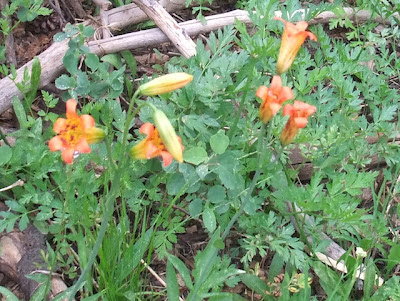 |
| Epilobium angustifolium (Fireweed) |
While fireweed was rare, this flower was everywhere, except for very dry and very hot locations.
We saw carpets of flowers that made you think of Heidi and burst into song (click the picture below to get the carpet idea).
"Must be an aster," I thought, thinking of the time of year. But now I'm no longer sure. The leaves were mostly at the base, which points to a daisy. Furthermore, we did see a plant that strongly resembles the plant formerly known as Aster occidentalis (western mountain aster) in dryer regions. Those flowers were purple and shaped differently.
My plant identification skills were similarly challenged with Monardella. We saw two different kinds. One purple, and more frequent in the granite areas.
Here's a close-up. Is this Monardella oderatissima (mountain pennyroyal)? It's certainly fragrant.
But in the darker, more vulcanic soil, we saw a very similar plant with white flowers. Is it the same plant? A slight variation? A different species?
Clearly I need to learn more about plant identification - and I need to carry Jepson's with me. Calflora does not even list Monardella odoratissima - though many other sites do - so this, too, shall forever remain a mystery.
A few plants were fairly rare, but I'm pretty sure of the identification. Here's Penstemon davidsonii (Alpine penstemon) a diminutive but beautiful perennial that was thriving in dry sunny spots.
And I think this is Penstemon newberryi (mountain pride) which I admired in cracks in the rock and other sharp drainage spots.
I initially had identification problems with this plant, which I thought might be a clarkia.
But the arrangement of multiple flowers on one stem made it pretty clear this had to be Sidalcea glaucens (checkerbloom).
I almost missed this plant, which we found in the moist meadows.
I was delighted to discover later that we'd seem Mertensia ciliata (mountain bluebells).
I also agonized over a lily-like plant with smallish orange flowers that we saw only in two spots on one hike. Is it really a lily or a fritilaria?
I think I'll go with Lilium parvum (alpine lily) because of the upright flowers, though clear identification is not possible.
So many questions still to answer, so many reasons to go back! My photos, all taken with a small point and shoot camera while not trying to slow down my fellow hikers, don't always help. And really, you need the smells and the sounds, you need the exhilarating walking in the fresh mountain air for the full enjoyment and appreciation of the plants and critters that live there. When can I go back?
 |
| Spirea densiflora (mountain spirea) |












Comments
I don't know what the aster is, though I saw tons of them. It might be an Erigeron or an Aster, but either way I think it's an all aster to me. I can't keep track of them; the plants look alike and it seems like the latin names often change. Maybe call them SKA? Some Kind of Aster?